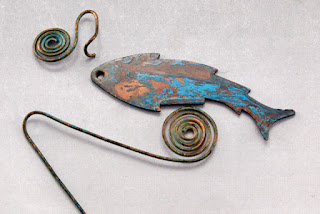I was delighted when she accepted my invitation to try out some different "recipes" for creating a patina on metal. Patina is just a fancy name for tarnish and oxidation. It will happen naturally on metals as they are exposed to oxygen in the air, a common example is the Statue of Liberty that has the classic green copper/bronze patina. Many people who work with metals prefer to speed up the process and by using different combinations of chemicals, heat and time can create varied and really beautiful finishes.
Sulfurated Potash (mostly potassium sulfide), commonly called Liver of Sulfur (LOS) is used by many jewelry makers as it is readily available, simple to use, fast and produces a nice brown to black patina on copper containing metals such as sterling silver, bronze and brass. There are many additions and variations to the simple LOS bath that I found searching the Internet and many of the variants use common household chemicals. Additionally, both Laura and I independently came across this collection of chemical recipes for patinas on the The Science Company website. We narrowed the options down to a few recipes we could do at home with reasonable safety.
We tried out 3 variations on the LOS recipes and a couple of Science Company chemical recipes. Details and more pictures can be found on Laura's blog.
On most of the flat pieces we also made marks with a black Sharpie to test it's ability to act as a resist to create a pattern in the patina.
1. Dilute LOS gel in hot water with a shot of vinegar:
observation: seemed to punch up the red/purple/blues
2. dilute LOS gel in hot water with a shot of ammonia:
observation: seemed to punch up the blue/greens
3. dilute LOS get substituting hot coffee for the hot water:
observation: we both liked the warm brown tone this produced.
Then we moved our operation out to the garage for the more laboratory type recipes.
don't panic, actually these chemicals are pretty safe, but they all had lots of CYA verbiage on the website and containers, so we made sure we were adequately prepared. Also, we were heating these up and didn't want to breathe any powders or fumes.
4. LOS patina, followed by dips in Ferric Nitrate and Cupric Nitrate:
observation: somewhat disappointing for round one, but further research makes me think this would work better by heating the piece then brushing or spraying and allowing the patina to form on the surface, built up in layers.
5. Ammonia fume (hanging the metal piece over ammonia solution in a sealed container:
observation: the first round was a major disappointment, we did get a nice yellowish green on the bronze wire in the first 15 minutes, which I quite like and may try to duplicate later.
6. Round 2 with Ammonia fumes, this time I bathed the pieces in vinegar and sprinkled salt on one side:
observation: I could see the reaction starting in 15 minutes, but it took at least an hour to get the nice blues. The above pictures are after sealing the pieces with Renaissance wax, which did remove a little and dull the colors slightly, but I think is necessary for long term preservation. Also, I think it might be better to try to dry the pieces as much as possible before starting the fuming.
Lessons learned:
- LOS variants are easy and safe, I will probably stick to them for the majority of my work
- Ammonia fume produces a really nice yellowish green on the bronze wire in the beginning stages, I might try this if I make another wire tree.
- The recipes that produce the thicker green/blue patinas worked much better on the flat copper pieces than the round bronze wire. I'm not sure if that is due to the layers not adhering as well to the round surface or the lower copper content of bronze vs pure copper.
- The Ammonia Chloride, Ferric Nitrate, Cupric Nitrate recipes would probably work much better with a micro-torch and spray bottle technique.
- I want to play with Laura again, she is fun, knowledgeable and really easy to talk with.









